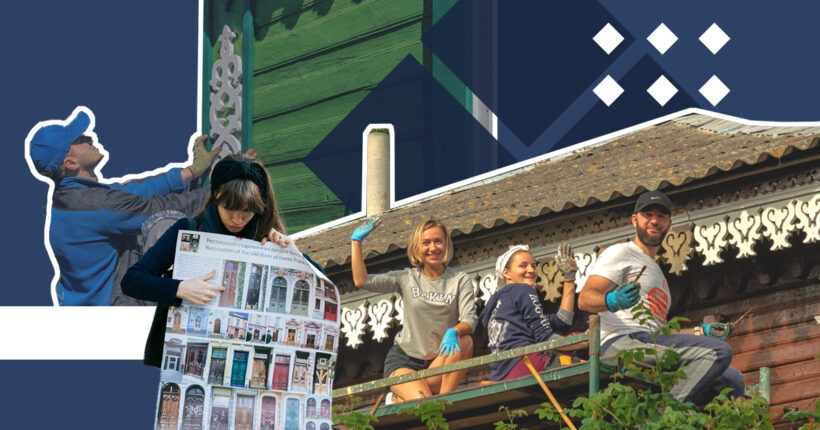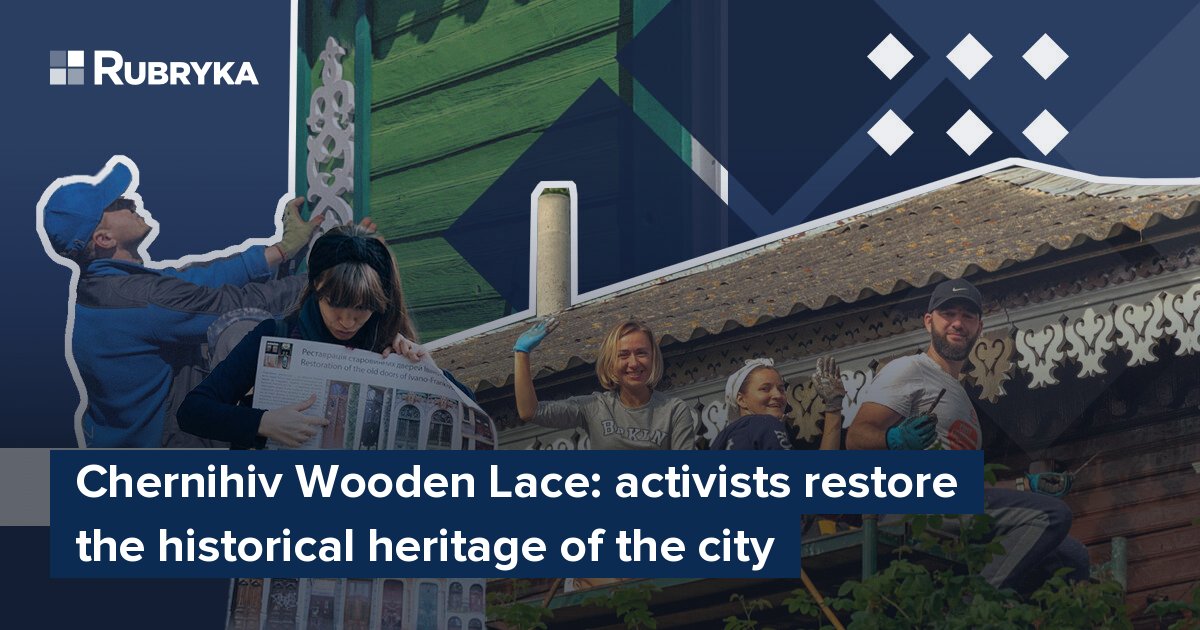
What is the problem?
Chernihiv is a city that was one of the first to take a hit at the beginning of a full-scale war launched by Russia in February 2022. Despite the destruction, a lot of historical architecture was preserved, and the works of wooden architecture remained neglected.
Wooden architecture decorated with wooden lace has always been traditional in this region. These are patterns cut into boards in the shape of birds, musical instruments, and other figures, which decorate windows, roofs, doors, and other parts of buildings.
Among the wooden architecture of Chernihiv are several monuments of architecture and history. Still, the authorities do not take care of them, let alone those buildings that do not have a protected status. Several centuries-old buildings are falling apart, and along with them is history.

Tairov's house in Chernihiv, built at the turn of the 19th and 20th centuries, is not in the best condition. Source: Chernihiv Wooden Lace
However, activist Stanislav Ivashchenko, who started working on restoring such structures in 2018 and continues to this day, despite the war, took up the problem. Rubryka investigates how it was and whether it is possible to repeat the experience in other cities of Ukraine.
What is the solution?
In 2018, together with other volunteers, Ivashchenko created the online museum Chernihiv Wooden Lace, putting about 200 of the most interesting objects of the region on an interactive map. In 2019, when the online museum already existed, the activist was invited to a village near Chernihiv, where a resident decided to make a museum out of her family estate and invited interested connoisseurs of wooden architecture. That is how Ivashchenko took up restoring wooden houses.

Volunteers restored a house at 2B Muzeyna Str. in Chernihiv. Source: Facebook page Chernihiv Wooden Lace
Most recently, at the beginning of August, the Chernihiv Wooden Lace activists completed restoring a wooden house on 2B Muzeyna Street. Forty people joined the restoration, and according to Ivashchenko, there is no need to look for volunteers — people find the organization themselves. Although the matter requires concentration for a month, and sometimes even more — as many as 30 sessions were needed to restore the house on Muzeyna Street, people's interest in creating something new does not wane.

The house's restoration process on 2B Muzeyna, in Chernihiv. Source: Facebook page Chernihiv Wooden Lace
There are already 11 houses on account of Wooden Lace. The process did not stop despite the war. According to Ivashchenko, there are damaged and destroyed wooden houses in Chernihiv, on the city's outskirts, and in the region. One of them was recently restored at 54 Shevchenko Street. The work was completed in August, and the new 12th restoration project has already been started.

Restored building on 2B Muzeyna Street, in Chernihiv. Source: Facebook page Chernihiv Wooden Lace
How does it work?
Even Ivashchenko himself does not say precisely how many people are on his team. Functions and roles are not distributed here; everything constantly changes, but it works. Activists choose buildings to be restored based on many factors: proximity to the center, complexity of carving (too simple objects are not accepted), and degree of damage, but the main thing here, of course, is the interest of the house owners.

Restoration of a house at 1 Zemska Street in Chernihiv. Source: Facebook page Chernihiv Wooden Lace
The restoration is financed in different ways: either the owner covers all costs, or everything is done with charitable contributions. Ivashchenko is collecting money for the project via MonoBank and Patreon. Works on one object can cost six to eight thousand hryvnias, if it is only about lace, and reach up to 40 thousand.

Restoration of a house at 1 Zemska Street in Chernihiv. Source: Facebook page Chernihiv Wooden Lace
What needs to be done to preserve heritage?
According to Ivashchenko, the local government does not help the process. Rather, it tries not to notice the activities because it is much more convenient to demolish old houses that are not privately owned and to sell and build on the plot than to keep the old property. To prevent buildings from being bricked up, which is a common practice, demolished, and damaged, the activist and his team do three things:
- document buildings in an online museum on their website;
- restore them physically;
- popularize the topic of wooden architecture.

A house in Zverinas near Vilnius was built around the 19th century. Today, as many as 108 old buildings in the district are included in the list of objects of architectural heritage. Source: lithuania.travel
In Europe, the authorities look at such sights differently. Ivashchenko said that he saw with his own eyes how the restoration of wooden buildings takes place in Vilnius. Everything is done at the level of the city authorities, and the projects have much more funding and, therefore, greater technical capabilities.
These houses look like new after restoration, and the heritage is preserved not by activists but by the state.
Chernihiv Wooden Lace and Tolocar
Previously, the ornaments were produced free of charge by Chernihiv Polytechnic on a CNC machine. It was very accurate but not very fast: it took about half an hour for a small piece of ornament, and a program had to be written separately for each part.

Restoration of a house at 1 Zemska Street in Chernihiv. Source: Facebook page Chernihiv Wooden Lace
The latest restoration involved the Tolocar, which is a converted van that has the capabilities of a makerspace or fablab on wheels. In fact, it is a small mobile workshop equipped with tools and equipment to support humanitarian activities in Ukraine, in particular reconstruction and restoration projects, open production, knowledge transfer, and innovation.
Usually, Tolocar travels all over Ukraine and even visits Europe. Kherson, Konotop, Truskavets, Berlin, Okhtyrka, Kyiv, and Chernihiv — that's where the team was just this summer.
What exactly is restored in wooden houses?
Usually, the team works only on the exterior facades: they cut, sand, paint, recreate, and install the missing parts. However, there was experience in reconstructing the object from the very foundation.

The process of creating new details of the facade of the house. Source: Facebook page Chernihiv Wooden Lace
Once, the owner wanted to completely restore the house of 1890. He himself managed the project and was the foreman, hired builders, and Wooden Lace was responsible for the decoration. Then, they made a new foundation around the old one, lifted the part of the structure with the rotten log-on jacks, pulled out the rotten logs, and replaced them with new ones. All the decoration boards were numbered and removed, the clapboard was cleaned, mineral wool insulation and a film protecting against moisture were installed on the log cabin, and the decoration was restored.
In this way, the building was protected from decay and moisture and insulated, and the wooden windows and lace were restored.
There are many similar initiatives in Ukraine!
Chernihiv Wooden lace is unique if we consider the restoration of buildings. However, they are not unique in the direction of their business — works of carpentry art or ancient "pieces" of the city, which imprint its history, are preserved all over Ukraine: in Ivano-Frankivsk, Odesa, and Kyiv.
Back in 2016, Maria Kozakevych launched the initiative Frankivsk, which must be protected. Activists restore old wooden doors and stained glass windows, create maps, and have their own merch to attract more attention to their activities. By the way, last year, the initiative expanded, and doors restored by Kozakevych appeared in Lutsk.

Maria Kozakevych shows the poster Frankivsk, which must be protected. Source: Ukrainer
Old doors are being actively restored in Odesa as well. There, the Thousand Doors of Odessa team traces the entire development of the city's carpentry art and has its own workshop for door restoration.

Photo of the door of Feldman's house at 43 Zhukovsky Street in Odesa before and after the restoration of Thousand Doors of Odesa. Source: Thousand doors of Odesa website
In Kyiv, the urbanist Yaroslav Fedorovsky founded the Maie znachennia fund and is engaged in restoring signs of the 20th century.

Yaroslav Fedorovsky on the background of a sign dismantled for restoration in 1978. Source: Fedorovsky's Facebook page
Rubryka asked Ivashchenko about what is needed to make a similar initiative in any city. The answer was simple and clear: "Stand up and start doing at least something," he said. He is right, and his experience proves that it is worth starting, and then people, stories, and publicity about good deeds will undoubtedly push for development.
Newsletter
Digest of the most interesting news: just about the main thing








